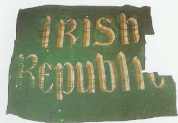The eminent linguist Dwight Bollinger put forward the notion of language as a ‘loaded weapon’, but in terms of describing what the events of Easter 1916 represent it is easy to imagine the language applied then and since as an attempt to unload the weapon. Variously described as a ‘Rising’, ‘Rebellion’, or ‘Insurrection’, these terms describe an event of relatively minor proportions, similar, in a sense, to waving a fist at an opponent. They are, of course, the words that were used by the British to downplay the significance of Easter 1916, and by the established political class in Ireland, including ‘Home Rule’ nationalists.
Revolution! Now there is a word to play with, a loaded weapon of a word. According to Aristotle, revolution is an attempt to effect a complete change from one constitution to another, and as the use of the word developed it has come to represent complete, abrupt change in the social order. A reading of the Proclamation of the Irish Republic confirms its revolutionary intent. No empty fist-waving there!
The consistent application of terms such as ‘The Poets’ Rebellion’ are nothing other than an attempt to take the air out of the Revolution by portraying it as a misty-eyed effete affair, a sentimental thing. Nothing could be further from the truth. Several of the leaders did write poetry among their other activities which included radical political activism, but each of the signatories of the Proclamation signed up to revolution knowing they would die for it. And revolutions, in any case, are forged not just by the leaders but also by the rank-and-file revolutionaries who rally to the cause.
One of the few attempts to understand the make-up of the revolutionary forces is an excellent study by Stein Ugelvik Larsen and Oliver Snoddy (Pádraig Ó Snodaigh) titled “1916 – A Workingmen’s Revolution? An analysis of those who made the 1916 revolution in Ireland”. Published in Social Studies in August 1973 it is a historical-sociological approach to the theoretical study of the Revolution. A key conclusion the authors arrived at is that “Altogether the picture of the 1916 revolutionaries indicates that this was a revolution undertaken by workers in alliance with small farmers, many middle and a few upper middle-class people. From the figures it does look like a perfect picture of a socialist revolution in the way Lenin and Marx envisaged it in their writings”.
While the full study is now available on this page under “Linked Articles”, it is worth reproducing, by way of illustration, one table that the authors compiled on the range of occupational groups among the (male) leaders and rank-and-file revolutionaries – 1146 men in total.
Occupation Number
1 General labourer 255
2 Farmer and Class VI General 174
3 Commercial clerk 115
4 On roads 56
5 Plumber and house painter 54
6 Porter, messenger 44
7 Grocer’s assistant 43
8 Carpenter, joiner 40
9 Shop assistant 30
10 Tailor 23
11 Machinist, machine worker 22
12 Artists 19
13 Draper 19
14 Teachers 19
15 Fitter and turner 18
16 Music, bookbinder, printer 18
17 Cabinet maker, upholsterer 17
18 Baker 17
19 Merchant 17
20 Broker, salesman, commercial traveller 15
21 Electrician, apparatus maker 14
22 Shoe, bookmaker, dealer 13
23 Blacksmith 13
24 Library and scientific 12
25 Apprentice, assistant 12
26 Coachmaker, motor-car assembler 11
27 Grocer 11
28 Hotel servant 10
29 Railway 10
30 Legal profession 8
31 Medical profession 7
32 Seamen, boatmen 6
In their study, the authors call for further research to be done to establish as complete a picture as possible of the rank-and-file revolutionaries, and one area for research certainly stands out – that of the women participants in the revolution. But looking at that table, incomplete as it is, demonstrates the nature of the revolution. It was that of a workers’ revolution, not bourgeois ‘rising’ or ‘insurrection’.
Let us take the loaded weapon back from the propagandists who peddle their dubious wares to stifle understanding of the totality of the revolution so that their ‘status quo’ can be maintained. No more talk of ‘The Poets’ Rebellion’ or any such guff. No more linking of the commemoration of the 1916 Revolution with commemoration of the filthy war of 1914-18, with permission to wear the Easter Lily only given if it is accompanied by the Poppy.
We owe a debt of truth not only to the revolutionary leaders but also the revolutionary rank-and-file. We must raise our voices above those, particularly in politics, the media and among the capitalist class, whose only project is to preserve their own interests by setting their own agenda firmly in the public consciousness. That agenda is to stifle understanding of the true nature of the 1916 Revolution and to bury the Irish Republic itself in a lime-filled grave. That agenda will be thwarted by today’s rank-and-file citizens creating streams of thought and creativity that bring back to life the hopes, aspirations and intent, not just of the leaders but especially of the rank-and-file revolutionaries – people just like us.
The 1916 Revolution belongs to us. The Irish Republic belongs to us. We will repossess both using the strength of our collective will and the loaded weapon of language – under our terms.
